Manuel Cuevas has racked up a serious slate of nicknames in his 90 years. The king of cowboy couture. A cutting-edge cowboy consultant.
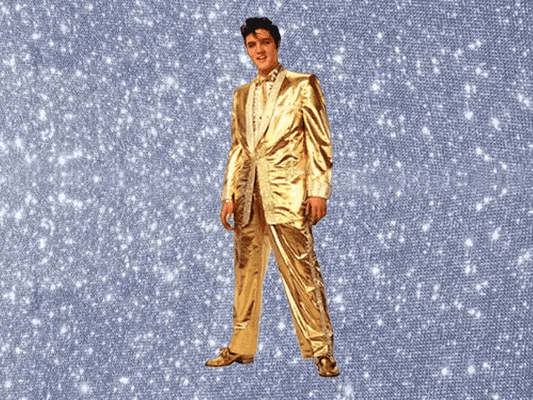
But he wants to be clear on one thing. Do not — I repeat — do not call him the Rhinestone Rembrandt. Vogue did once, decades ago, and he’s been trying to shake it off ever since.
“First of all, I am not the Rhinestone Rembrandt,” he says in a gravelly baritone. “I am not. Please. Am I the best tailor in the world? Nope. I am one of the better ones. But I’m not the best.”
Cuevas is known as simply Manuel, the Beyonce of western wear. He wears a signature scarf tied around his neck, giving him a look of perpetual debonair, with his white wavy hair combed back.
Working with his mentor, Nudie Cohn, he took a suit, known as the “Nudie Suit”, and turned it into a legend.
Instantly recognizable for their grandeur, Nudie Suits are worn on red carpets, in music videos, and on movie screens around the world. They sell for tens of thousands at auction and have influenced countless western wear designers across the country.
Over the years, Manuel has become a legend too, his unique brand of glammed-up country garb represented in museums and on red carpets, earning him accolades and proteges of his own. Eighty-three years in, he’s still sewing.
Ask Manuel and he’ll tell you he’s never worked a day in his life. But behind his passion is a heady mix of drive, vision, and luck that has helped him create a stage-wear empire.
So what the heck is a Nudie Suit?
You know ‘em when you see ‘em – the vibrant two-piece suits patterned with constellations of rhinestones and covered in embroidered tapestries. They rose to fame in the 1950s, after Tex Williams started wearing them and Nudie’s Rodeo Tailors, under the helm of Nudie Cohn, really took off.
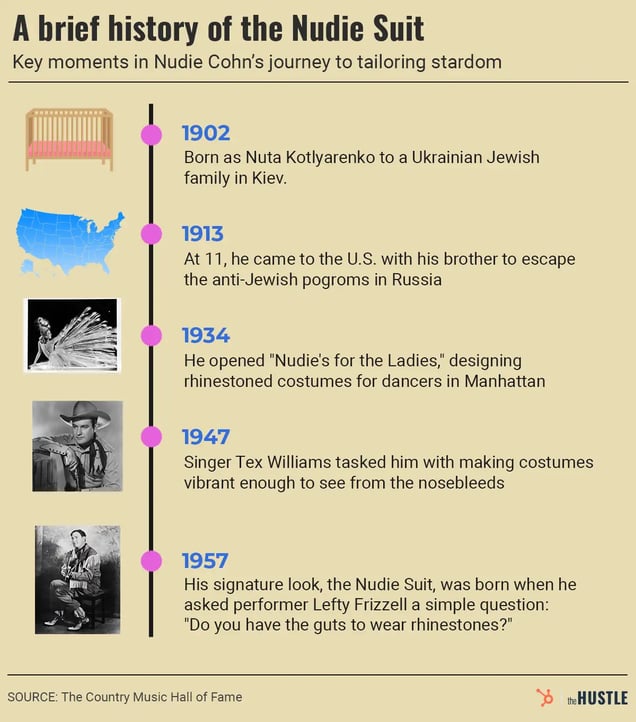
The Hustle
While Nudie was out on the floor, selling hard, Cuevas was in the back sitting at the sewing machine. Cuevas, who worked with Cohn for 14 years, first as a tailor, then head tailor, designer, and partner, drew and stitched and fitted for the world’s most famous stars.
“Pants maker wanted”
Cuevas started sewing at seven years old, as a child in the town of Coalcoman, Mexico. He was fifth of 12 children, and his older brother needed help with a business of his own.
“I just fell into it because my brother was sewing pants,” he says. “I never dreamed of being a designer or anything like that, no, no, no, no, no. I’m still sitting at that stupid sewing machine doing exactly the same thing.”
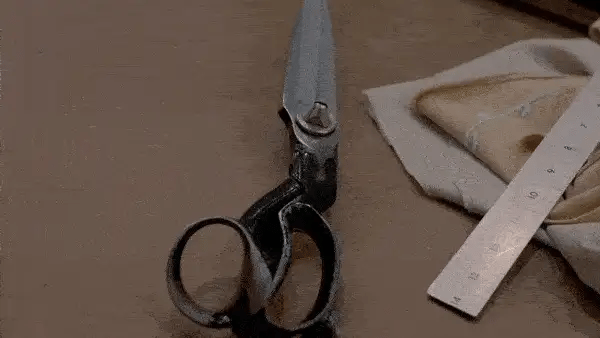
Manuel Cuevas, tailor to the stars, says his clients don’t find out what he’s creating for them until they come to pick up their finished suits. (Estelle Caswell)
His talent for sewing and eye for design were undeniable. By 13, he was sewing prom dresses for the girls in his town. Later, he made shoe-shine boxes out of wood and leased them to other people.
He did so well that he left Mexico bound for L.A. in a Cadillac with a paper bag holding $40k — or so the story goes. Cuevas is overflowing with stories, filled with the kinds of tall tales that come from working a lifetime in show business.
When he passed a sign on Pasadena Avenue that said “pants maker wanted,” he applied and got the job, at 80 cents an hour. From there, he bounced from shop to shop.
Before long, he was hired by Sy Devore to do fittings on his clients, which included the Rat Pack. Making suits for Frank Sinatra grew repetitive, and he tired of the monotony.
You’d think a chance meeting with Frank Sinatra might change your life, but it was a different opportunity that altered the course of Manuel’s. His girlfriend asked him to go with her to the Parade of Roses. “What the heck is that?” he responded.
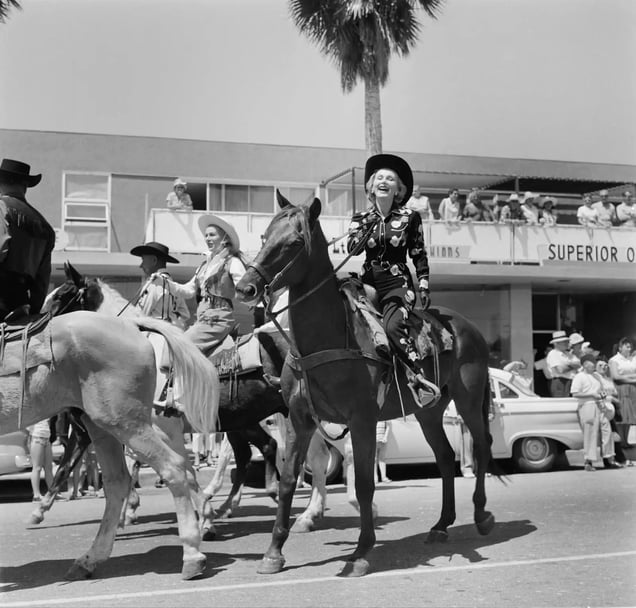
A woman in western wear on horseback at the 1958 Rose Parade in Pasadena. (Earl Leaf/Michael Ochs/Getty Images)
When they arrived at the annual parade with rose-encrusted floats, cavalry, and marching bands, he was struck immediately by the embroidery decorating the outfits. Who was that? He had to know who’d crafted the grandeur cascading from the riders.
“What I discovered there is what I do every single day of my life,” he says.
It was Viola Grae, and he convinced her to trade him embroidery lessons for pattern cuttings. He decided that day he’d have a shop of his own, making custom Americana creations.
Grae introduced him to Nudie Cohn, the exuberant salesman who ran Nudie’s Rodeo Tailors, and in 1961, Manuel went to work for him as lead designer. The pair formed a partnership so close that Manuel eventually married Cohn’s daughter Barbara and became his son-in-law.
It was the start of the swinging ‘60s, and the pair’s designs tore through Hollywood. The Beatles came calling; so did Johnny Cash, Elvis Presley, and Gram Parsons.
The real money was in the movies, supplying Hollywood with western wear for its films. Under the guidance of eight-time-Oscar winner Edith Head, Cuevas:
- Put James Dean in jeans for Giant
- Fitted Clint Eastwood for spaghetti westerns
- Created a mask for the Lone Ranger
Back at the shop, meanwhile, he and Nudie were putting the finishing touches on the suits that would become their hallmark.
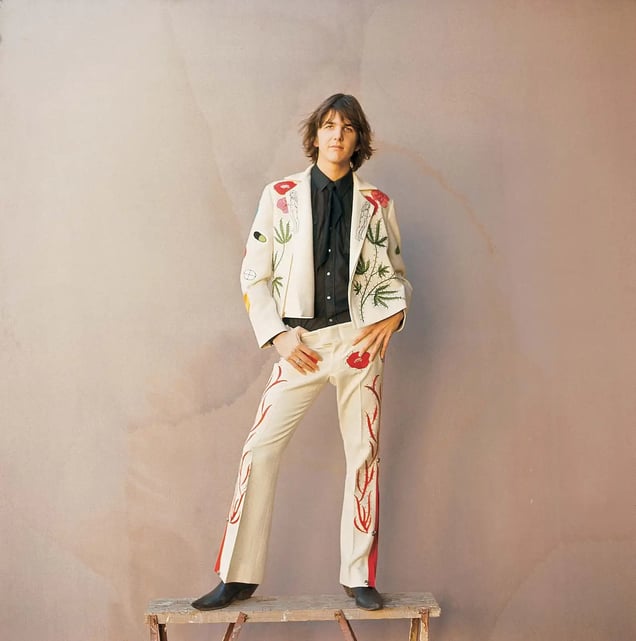
Gram Parsons, a longtime client of Nudie’s Rodeo Tailors and Manuel Couture, poses in his iconic marijuana-encrusted Nudie Suit. (Jim McCrary/Redferns/Getty Images)
When Cohn worried they’d never sell one, Cuevas replied, “We will sell more than anybody.”
And they did.
When the business relationship fell apart 14 years later, the personal one did too (or vice versa). Either way, neither Manuel’s partnership nor his marriage ended amicably. He decided to strike out on his own.
Going it alone
He moved down the block, a taunt’s worth of distance between his new Manuel Couture and Nudie’s Rodeo Tailors. He took some of Nudie’s tailors and embroiderers with him, along with a client list any solo entrepreneur would kill for.
“To be in Hollywood, you have to have strong knuckles,” he says.
At his own shop, he put the finishing touches on his style. Before he’d left Mexico, he earned a degree in psychology from the University of Guadalajara, and it came to serve him well as a designer.
“I listen to the client. I talk to them,” he says. “Really, you just mirror them with your ideas, and the things that they feel, who they are. You create them, you make them grow.”
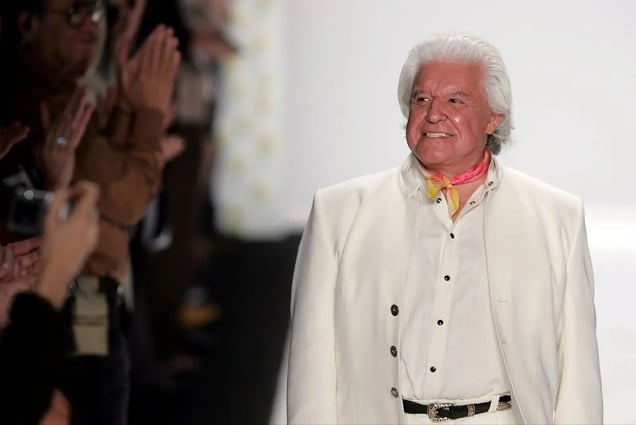
Manuel Cuevas walks the runway at Bryant Park after presenting his collection during Olympus Fashion Week in New York in 2007. (Mark Mainz/Getty Images for IMG)
By then, he was designing and styling for Johnny Cash, Elvis Presley, and the Grateful Dead. When Dwight Yoakam wore a cropped turquoise California Jacket by Manuel on the cover of his Hillbilly Deluxe album in 1987, Cuevas’s shop fielded thousands of calls from customers who wanted one of their own.
By 1988, he had a second wife and three kids, and L.A. no longer felt like a safe place to raise them. He moved his family and his business to Nashville, around the corner from the Country Music Hall of Fame.
He became a fixture of the country music scene: He made nine black suits for Johnny Cash before black was his thing. He created a dazzling wardrobe for Marty Stuart. He’s dressed three generations — “so far,” he jokes — of Hank Williamses.

The Hustle
His work is instantly recognizable: vibrant colors that tiptoe right up to garish, rhinestone patterns that would make any Bedazzler jealous. His style is an artistic amalgam of motifs from Alaska to Patagonia, inspired by the work of tailors like Nathan Turk and Nudie Cohn, of course, and the Mexican vaqueros before them.
“Less is never more for Manuel,” says Janet Aspley, a dress historian and shirt maker who wrote her University of Brighton PhD on the stagewear designers like Cuevas and Cohn created. “The aesthetic is very kitsch. His Mexican influence really comes through, in those short jackets.”
It comes through in the butterflies and nopales cascading down the sleeves of his suits, too. Aspley calls his embroidery “painting with a needle.”
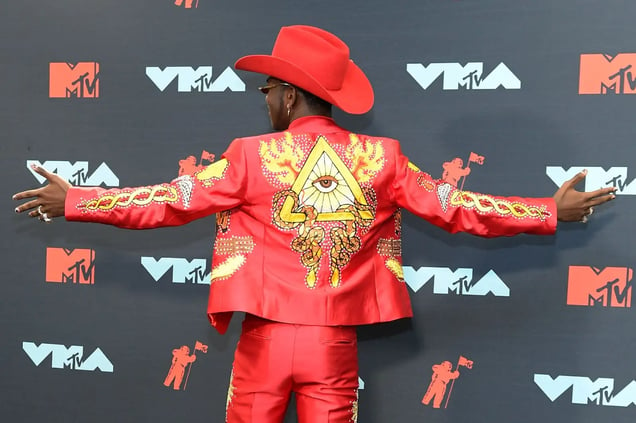
Lil Nas X wears a Manuel-inspired Nudie Suit by Union Western to the MTV Video Music Awards in 2019. (Roy Rochlin/Getty Images for MTV)
His work has spawned other designers, too, who have outfitted celebs in Cuevas-inspired garb:
- Lil Nas X wore a Nudie suit designed by Indianapolis tailor Jerry Lee Atwood, for his label Union Western, in his smash hit Old Town Road music video
- When Atwood got an Instagram DM from a celebrity stylist, he had to look up the name Post Malone. The rapper would later wear one of Atwood’s suits to the American Music Awards
- Austin-based Fort Lonesome has dressed Diplo, designing him a jacket emblazoned with his name and embellished with an astronaut carrying mushrooms
While custom Nudie suits made by Manuel or Union Western are largely for performers, celebrities, and moneyed country aficionados, some labels, like Fort Lonesome, offer ready-to-wear options for the Nudie-curious among us.
A vintage Nudie-inspired suit on Etsy, for example, will run you ~$600, and Fort Lonesome offers one in its “Haus of Shiny Shit” web shop for $16k. A skull-adorned pair of pants made for The Grateful Dead’s Jerry Garcia by Nudie Cohn himself went for $21k two years ago at Sotheby’s. Manuel’s creations start at $3.5k for a jacket and go up from there.

The Hustle
When Aspley first walked into Manuel’s shop, it felt to her like a jewelry box come to life, rhinestones glittering and a rainbow of colors around every corner.
She spotted a cropped women’s jacket, red rhinestones and embroidery overlaid on red fabric. It was $4k, but she had to try it on. “It looked fabulous. I nearly bought it. I thought, I could just put it on my credit card…” she says. But she was a PhD student, living off grants. “It’s a regret that I live with.”
The next time she returned, the one-of-a-kind jacket was gone.
The tallest tale of all
Cuevas still gets up every morning and arrives at his shop in Nashville’s Berry Hill. Spools of thread span the wall like a rainbow. Surrounded by racks of jackets, jars of brass buttons, and armed with a coffee in a paper cup, he puts pencil to paper, sketching out looks that have come to him in his dreams the night before.

Cuevas prefers a life behind a sewing machine to one in front of the camera. “I could be in the circus, but I don’t do somersaults. I’m not that kind of a guy.” (Estelle Caswell)
He has no plans to retire, though his fourth wife, Maria, and a small team of artists help with the finer embroidery and stitchwork now.
“Tailoring is no different than being a carpenter or being a cement mixer,” he says. “We just have to find ourselves and really do what we want to do and go for it. And we can make that thing called money.”
Cuevas credits his drive to good food and fresh air. Tequila helps, too, and so does novelty. He prides himself on never making the same design twice. When it comes to all he’s accomplished, he raises his palms to the sky.
“I’m just a little wood-maker from Tijuana,” he says slyly. “No big deal.”
That might just be the tallest tale of all.


